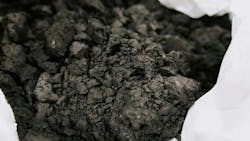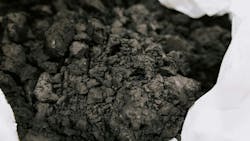Unlocking the Bright Side of Black Mass in Lithium-Ion Battery Recycling
Black mass isn’t as grim as it sounds. It’s the material left over at the end of the lithium-ion battery production process. Recycling lithium-ion batteries requires processing and drying of the black mass downstream of the mechanical shredding-crushing-granulating operations.
Black mass contains the cathode active material (lithium, nickel, cobalt and manganese), anode active material (graphite, silicon and lithium) and residual metals (copper and aluminum). Drying the material is critical for several reasons. First. and most importantly, is safety. After the mechanical operations, which I discussed in my last column, the black mass contains electrolytes (solvents) that are hazardous to both operators and the plant environment. Secondly, a dried black mass allows for improved separation of the active materials in the subsequent operations. This means drying or evaporation of the electrolytes allows for materials recovery and reuse while eliminating emissions to the external environment.
Dryer Technologies for Black Mass
Battery processors can use three types of main dryer technologies for black-mass drying: a horizontal paddle dryer, vertical helical dryer or circular plate dryer. Each dryer heats the material slowly and operates in a batch mode under vacuum. The vacuum is pulled through an integrated dust filter, which removes any product/black mass fines and protects the downstream electrolyte recovery process.
A horizontal paddle dryer can operate at temperatures up to 650 degrees C with very close wall tolerances of the paddles to avoid crust formation on the dryer vessel walls. Paddle dryers also can operate at low temperatures under vacuum drying conditions. The paddle designs convey the solids forward and backwards, creating a three-dimensional turbulent zone for optimum mixing or drying. Processors also can heat paddles for added heat transfer to the powders.
In a vertical conical dryer, helical arms move the solids upward and downward for both axial and radial mixing or drying with very close wall tolerances. Baffles further assist for maintaining even temperature distribution and maximum heat transfer. The helical arms are also heated for additional heat transfer to the product.
A plate dryer consists of stationary, horizontal circular plates, which are heated while rotating arms with plows gently transport the product across the heated surface of the plates. The thin product layer on the surface of the plates in combination with frequent turning over of the product results in a short retention time and uniform drying. This protects the product against thermal degradation and prevents particle breakage. The fixed plates have a jacket on the underside and can be heated or cooled with water, thermal oil or steam.
Electrolyte Solvent Handling
During the vacuum drying process, the remaining electrolyte evaporates depending upon the dryer pressure (vacuum) and product temperature. The vapor is pulled through a pre-condenser then a vacuum pump followed by a post-condenser. A gas treatment system purifies the remaining nitrogen gas flow.
There are many options for the gas-treatment step. For example, operators can install a gas scrubber for adsorption and/or neutralization with the appropriate liquids as well as a counter-current activated carbon system. Alternatively, operators can use a rotary thermal oxidizer that may already exist within the plant. The local environmental permitting regulations for air emissions will determine the final design of the gas-treatment approach.
After the electrolytes are condensed, processors may need to perform further treatment depending how they reuse or recycle electrolytes at the plant. For example, they may need to perform cooling as well as final polishing cartridge or bag filters along with the associated tanks and pumps for complete containment during transfer back to the process.
Sustainable Electrification With Optimal Project Design
Several alternatives are available for black-mass recovery and electrolyte solvent recovery and reuse. As with the mechanical operations discussed previously, each alternative has advantages and drawbacks. A deciding factor, though, must be operator and environmental safety. At the same time, an optimal process design provides for maximum solids and liquid recovery to transition from a linear economy of battery disposal to a the more sustainable electrification model.
About the Author
Barry Perlmutter
President of Perlmutter & Idea Development (P&ID) LLC
Barry Perlmutter is president of Perlmutter & Idea Development (P&ID) LLC. He has over 40 years of science, engineering and business marketing experience in the field of solid-liquid separation including filtration, centrifugation, process drying, mixing and recycling. His strong professional skills focus on process and project solutions, innovation strategies and execution, market expansion and business development. Barry has published and presented worldwide on applications in the chemical, pharmaceutical, and energy/environmental industries and has been responsible for introducing many European technologies into the Americas marketplace. His two books, published by Elsevier, Amsterdam, "Handbook of Solid-Liquid Filtration" and "Integration & Optimization of Unit Operations" are used worldwide for process guidance.


